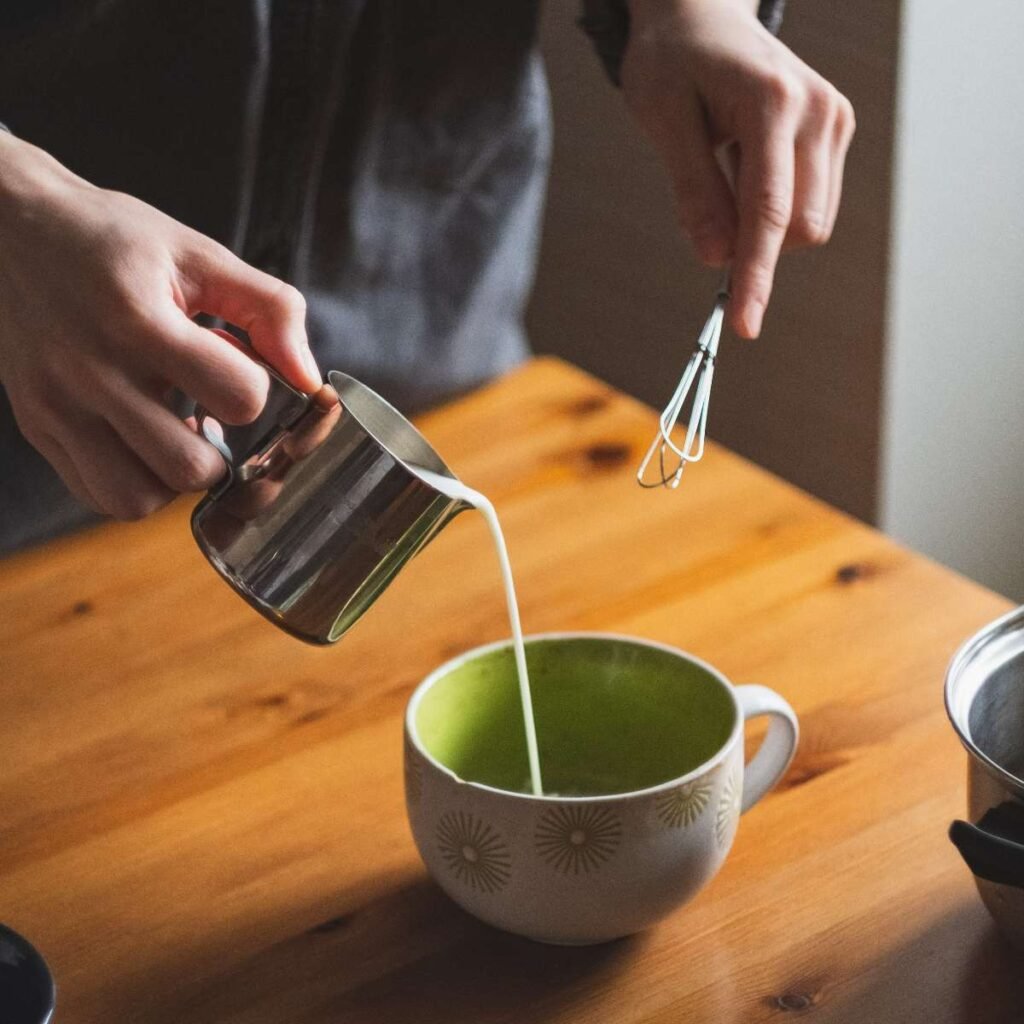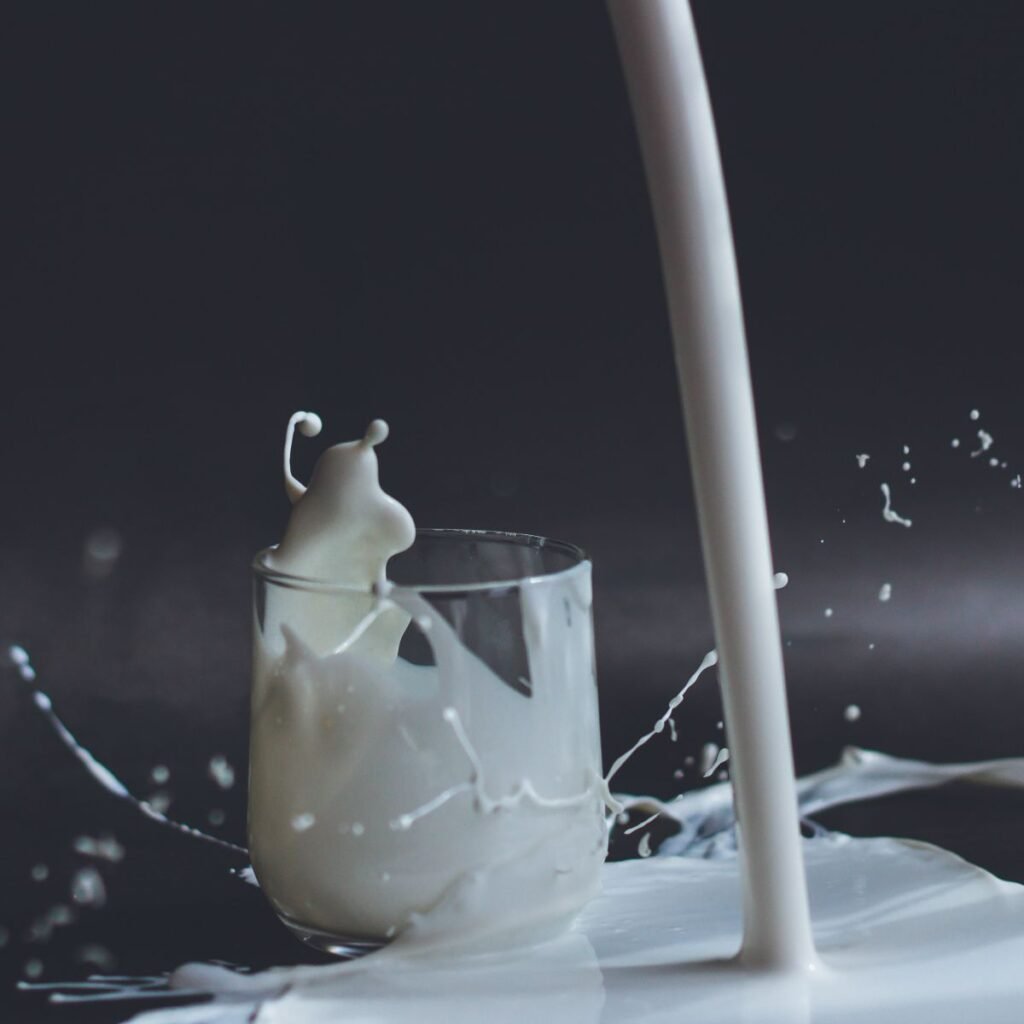Yellow foods not only bring a splash of color to our plates but often tantalize our taste with flavors ranging from sweet to savory.
Whether you’re a curious foodie or someone looking for inspiration to add a ray of sunshine to your meals, join me to explore 129 foods that boast this cheerful color. Get ready to be delighted by nature’s yellow palette! From Vegetables to fruits to aromatic species.
Let’s get started!!
Yellow Vegetables
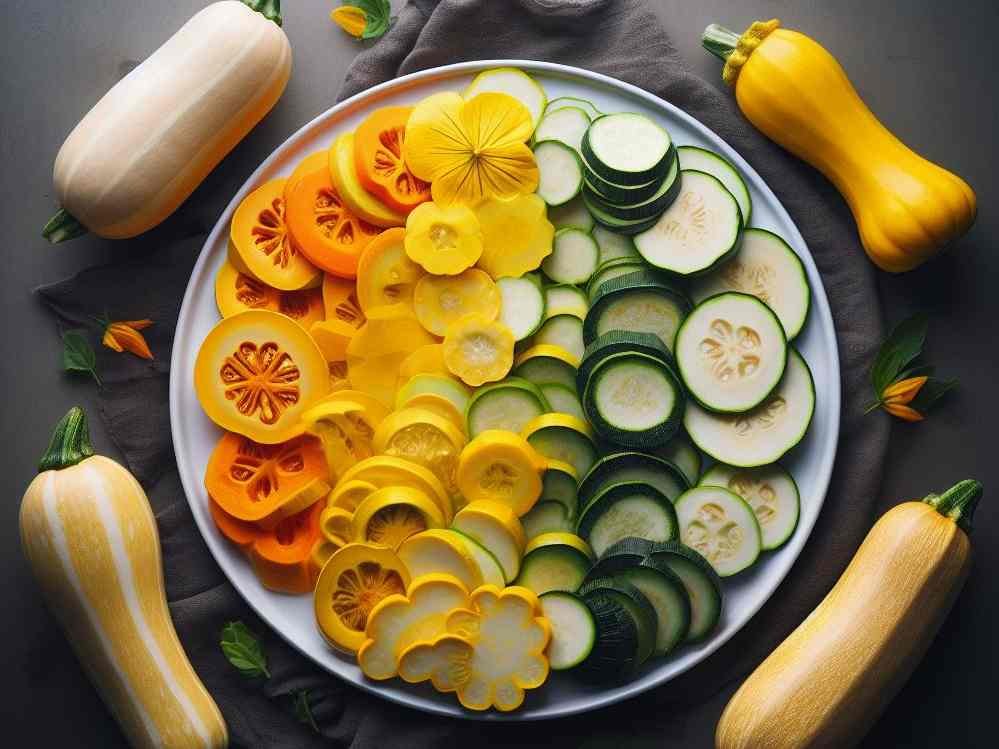
1. Yellow Zucchini (or Yellow Courgette)
This looks like the green zucchini but is bright yellow. It’s long and cylindrical with a smooth skin.
2. Crookneck Squash
Recognizable by its curved neck and bumpy skin. It’s often bright yellow and has a mild flavor.
3. Straightneck Squash
Similar in flavor to the crookneck but, as the name suggests, it has a straight neck.
4. Yellow Pattypan (or Scallop) Squash
This is a small, disc-shaped squash with scalloped edges. It can come in yellow, green, or white, but the yellow variety is quite common.
5. Golden Zephyr
This is a hybrid variety that’s smooth-skinned and has a slightly nutty flavor.
6. Sunburst Squash
A type of yellow pattypan squash, it’s known for its bright yellow color and round, flat shape.
7. Goldbar Squash
This is a more elongated yellow squash, similar in shape to zucchini but with a deep yellow color.
8. Yellow Bell Peppers
These are sweet peppers that are often used in salads, stir-fries, and other dishes.
Yellow Tomatoes: These can range from cherry-sized to full-sized beefsteak varieties.
9. Yellow Pear tomatoes
As the name suggests, these are small, pear-shaped tomatoes. They’re sweet and perfect for salads.
10. Lemon Boy
This is a larger, round tomato with a vibrant yellow color and a mildly sweet flavor.
11. Golden Jubilee
A beefsteak variety, these tomatoes are large and have a sweet, mild flavor.
12. Golden Sunray
Another beefsteak variety, it’s large and has a deep yellow hue.
13. Taxi Tomatoes
A medium-sized early variety, it’s bright yellow and has a tangy flavor.
14. Yellow Brandywine
A yellow version of the popular Brandywine tomato, it’s large and has a rich flavor.
15. Golden Queen Tomatoes
This is an heirloom beefsteak variety with a mild flavor.
16. Pineapple Tomatoes
Not to be confused with the fruit, this tomato is large and bi-colored, with yellow flesh streaked with red. It has a sweet, fruity flavor.
17. Gold Medal Tomatoe
Another bi-colored variety, it’s large with yellow and red streaks and has a sweet flavor.
18. Yellow Cherry
These are small, round, and sweet, perfect for snacking or adding to salads.
19. Golden Roma
A yellow version of the classic Roma tomato, it’s great for sauces and pastes.
20. Aunt Gertie’s Gold
An heirloom variety, it’s large and has a sweet, fruity flavor.
21. Tumbling Tom Yellow
A cherry tomato variety that’s perfect for hanging baskets.

22. Yellow Carrots
While orange is the most common color for carrots, they can also be found in yellow.
23. Yellow Beets
These are less common than red beets but have a sweeter taste.
24. Sweet Corn
While not exclusively yellow, many varieties of sweet corn have yellow kernels.
25. Golden Potatoes
These have yellowish skin and flesh.
26. Yellow Cauliflower
A less common variety compared to the white one but has a similar taste.
27. Yellow Wax Beans
Similar to green beans but yellow in color.
Yellow chillis
28. Yellow Chilies
These can range from mild to hot.
29. Aji Amarillo
Native to South America, particularly Peru, this chili has a fruity flavor and medium to hot heat level.
30. Lemon Drop (or Aji Limo)
This is a Peruvian chili with a citrusy flavor and a heat level that’s quite hot.
31. Yellow Wax (or Banana Pepper)
These can range from mild to medium in heat. They are often pickled and used on sandwiches or pizzas.
32. Hungarian Wax Pepper
Similar in appearance to the banana pepper but can be hotter. It’s often used in Hungarian cuisine.
33. Santa Fe Grande (or Yellow Hot Chili Pepper)
These are conical chilies that are medium in heat.
34. Fatalii
Originating from Central and Southern Africa, this chili is one of the hotter ones, with a fruity citrus flavor.
35. Golden Cayenne Pepper
A yellow version of the well-known red cayenne pepper, it’s long and skinny with a hot heat level.
36. Bhut Jolokia Yellow (or Yellow Ghost Pepper)
A yellow variant of the infamous ghost pepper, it’s extremely hot.
37. Yellow Scotch Bonnet
Similar in heat and flavor to the habanero but with its own distinct shape, it’s very hot.
38. Yellow Habanero
One of the hotter chilies, it has a fruity flavor.
39. Peach Sugar Rush
A long pod-type pepper with a fruity flavor and medium heat.
40. Aji Pineapple
A chili with a fruity, pineapple-like flavor and medium heat.
41. Yellow Cucumbers
Some specific varieties of cucumbers are yellow when ripe.
42. Yellow Onions
While the outer skin is often more brownish, the flesh can be yellow
Fruits that are Yellow
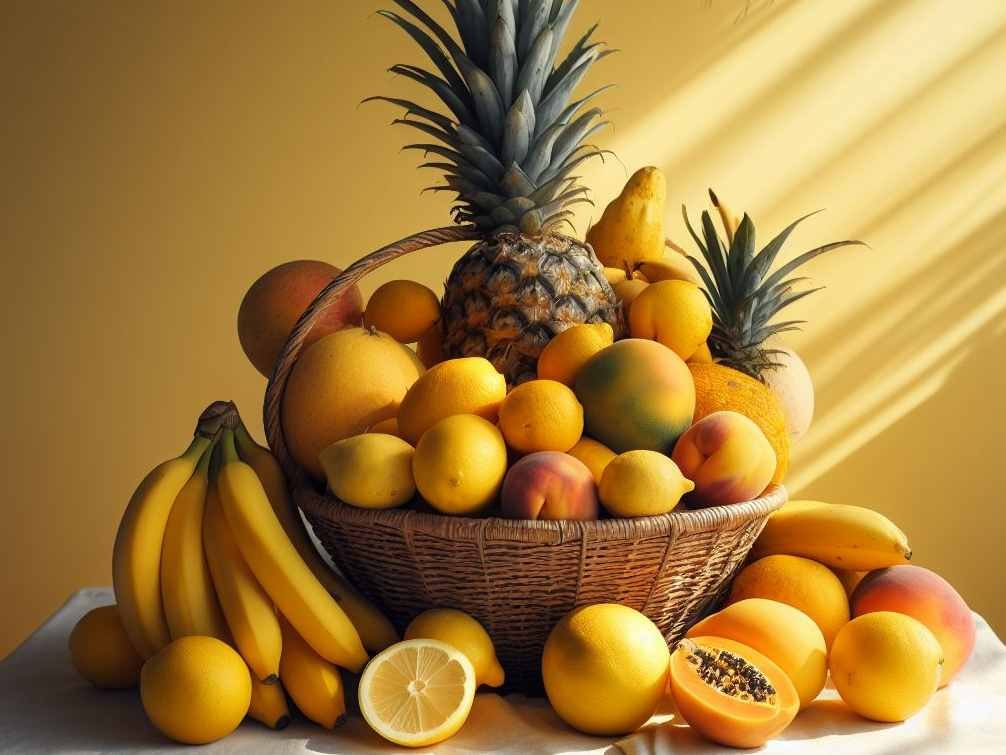
43. Bananas
One of the most recognized yellow fruits, they’re sweet and commonly consumed worldwide.
44. Lemons
These are sour and are often used for their juice, zest, or as a garnish.
45. Pineapples
A tropical fruit with a sweet and tangy flavor. Also, learn if you need to refrigerate pineapple after cutting.
46. Mangoes
While they can come in a range of colors, many varieties have yellow skin or flesh when ripe.
47. Papayas
These have a sweet, orange-yellow flesh inside.
48. Yellow Apples
Varieties like Golden Delicious are yellow when ripe.
49. Yellow Watermelon
Less common than the red variety, but it has a sweet yellow flesh inside.
50. Yellow Passion Fruit
The outer skin is purple or yellow, but the yellow variety is larger and less acidic.
51. Yellow Kiwi (or Gold Kiwi)
Sweeter and less tangy than the green variety.
51. Yellow Pears
Varieties like the Bartlett can turn yellow when ripe.
52. Yellow Figs
Some fig varieties have a yellow or greenish-yellow skin when ripe.
53. Yellow Guava
It has a sweet flavor and can be eaten raw or used in cooking.
54. Starfruit (or Carambola)
This fruit is star-shaped when sliced and has a crisp, juicy texture.
55. Canary Melon
This melon has a bright yellow skin and a sweet, white flesh.
56. Golden Berries (or Cape Gooseberries)
Small, round fruits that are sweet with a hint of tartness.
57. Jackfruit
When ripe, it has a sweet, yellow flesh that can be eaten raw or used in various dishes.
58. Yellow Dragon Fruit (or Yellow Pitaya)
Less common than the pink-skinned variety, it has a sweet, juicy flesh with tiny seeds.
59. Golden Berries (or Cape Gooseberries)
Small, round fruits that are sweet with a hint of tartness.
60. Jackfruit
When ripe, it has a sweet, yellow flesh that can be eaten raw or used in various dishes.
61. Yellow Plums
Also known as mirabelle plums, they are sweet and often used in jams and baked goods.
62. Yellow Raspberries
Less common than red or black raspberries, they have a sweet, delicate flavor.
63. Yellow Cherries
Varieties like Rainier cherries have a yellow-red hue and are very sweet.
64. Yellow Grapefruit
Varieties like Oro Blanco are sweeter and less bitter than the pink or red grapefruits.
65. Yellow Grapes
Some grape varieties are golden or yellowish when ripe.
66. Yellow Nance Fruit
A small, round fruit often found in Central and South America.
67. Loquat
A small, round fruit with a tangy flavor, it’s native to China but grown in many parts of the world.
68. Kumquat
A tiny citrus fruit that can be eaten whole, including the skin.
69. Jujube (when ripe)
Also known as Chinese dates, they turn yellow or red when ripe and have a sweet, apple-like flavor.
70. Yellow Sapote
Also known as eggfruit, it has a sweet, custard-like texture.
71. Yellow Mombin
A tropical fruit found in parts of the Americas, it’s also known as hog plum or Spondias mombin.
72. Buddha’s Hand
A type of citrus that doesn’t have juice or pulp but is used for its zest and aromatic properties.
73. Durian
Known as the “king of fruits” in Southeast Asia, it has a strong aroma and a custard-like yellow flesh.
74. Langsat
A Southeast Asian fruit that has a translucent, juicy flesh with a sweet and sour taste.
75. Chikoo (or Sapodilla)
When ripe, it has a sweet, grainy texture similar to pears.
76. Yellow Persimmons
Some persimmon varieties turn yellow when ripe and have a sweet, honey-like flavor.
77. Atemoya
A hybrid fruit that combines the sugar apple and cherimoya, it has a sweet, creamy texture.
78. June Plum
Also known as ambarella, it can be eaten raw when it’s green and crunchy or when it’s ripe and yellow with a sweeter taste.
Yellow spices
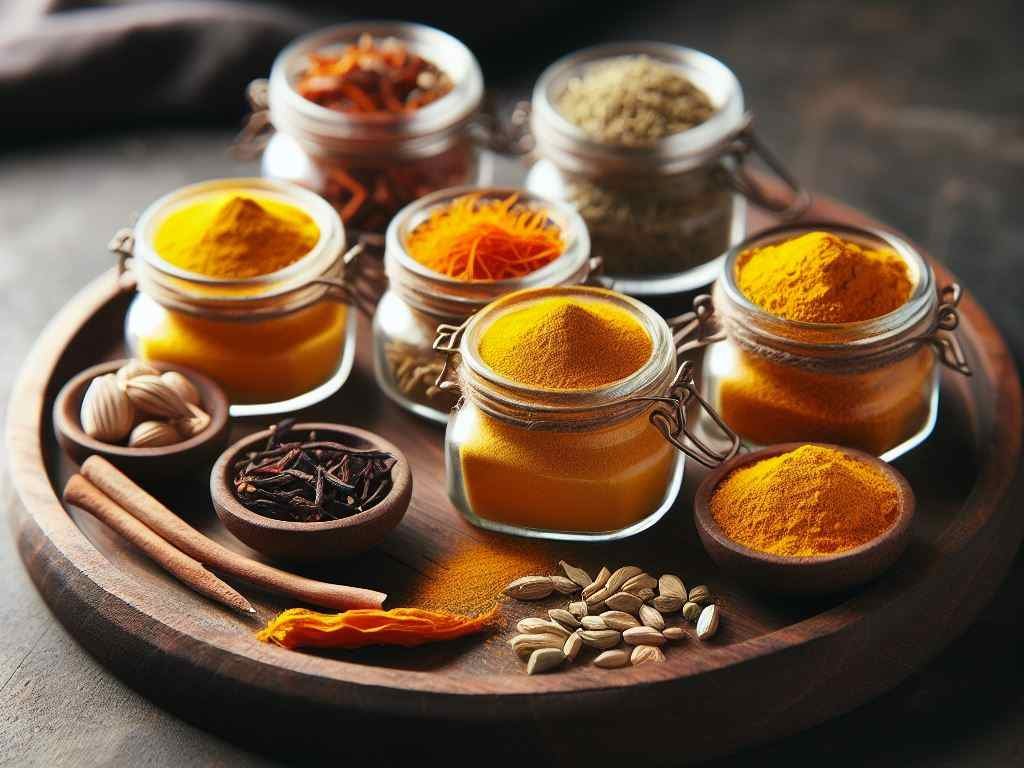
79. Turmeric
A root spice that’s often dried and ground into a bright yellow powder. It’s a primary ingredient in many curry powders and is known for its potential health benefits.
78. Saffron
Derived from the stigma of the crocus flower, saffron threads have a deep yellow-orange color and can impart a golden hue to dishes. It’s one of the most expensive spices due to the labor-intensive harvesting process.
79. Yellow Mustard Seeds
These are the seeds of the white mustard plant and are less spicy than their black or brown counterparts. They can be used whole, crushed, or ground into mustard powder.
80. Fenugreek
While the seeds themselves are amber-colored, they can impart a yellowish hue to dishes, especially when ground.
81. Curry Powder
While not a single spice, curry powder is a blend that often includes turmeric, which gives it a yellow color. The exact composition can vary, but it typically imparts a yellow hue to dishes.
82. Annatto
Derived from the seeds of the achiote tree, annatto has a slightly nutty, peppery taste and is often used to impart a yellow or orange color to foods.
83. Ginger
Fresh ginger root has a pale yellow flesh, and when dried and ground, the powder can have a yellowish tint.
84. Galangal
Similar to ginger, galangal is used in many Southeast Asian cuisines and has a yellowish hue when cut.
85. Asafoetida (Hing)
Often used in Indian cooking, it’s a resin gum that turns yellow when cooked and has a strong, pungent smell.
86. Yellow Cardamom (or Bastard Cardamom)
Less common than green or black cardamom, the pods are larger and have a milder flavor.
Protein-rich foods that are yellow (or have a yellowish hue)
87. Eggs
Specifically, the yolks are yellow. Eggs are a complete protein source, containing all essential amino acids.
88. Yellow Lentils
Lentils are a good source of plant-based protein.
89. Chickpeas (Garbanzo Beans)
Often used to make hummus, these beans are a good source of protein.
90. Yellow Split Peas
These can be used to make soups and are a good source of protein.
91. Tofu
While tofu is typically white, when marinated or cooked with turmeric or other yellow ingredients, it can take on a yellow hue.
92. Tempeh
This fermented soy product can sometimes have a yellowish tint, especially if made with added grains or seasonings.
93. Yellow Fin Tuna
While the flesh is more on the pink side when raw, it can appear yellowish when cooked, especially the lighter parts.
94. Edamame
Young soybeans can have a yellowish tint when matured and are a good source of protein.
95. Yellow Cheese Varieties
Such as cheddar, gouda, or emmental. Cheese is a good source of protein, though it also contains fat.
96. Chicken
While chicken meat is not strictly yellow, the skin can be, and chicken is a significant source of protein.
97. Yellow Corn (Maize)
While not as protein-rich as legumes or animal products, corn still provides a decent amount of protein.
98. Mustard Seeds
These seeds have protein, and they’re often used as a spice or to make mustard sauce.
Edible Mushrooms that are yellow
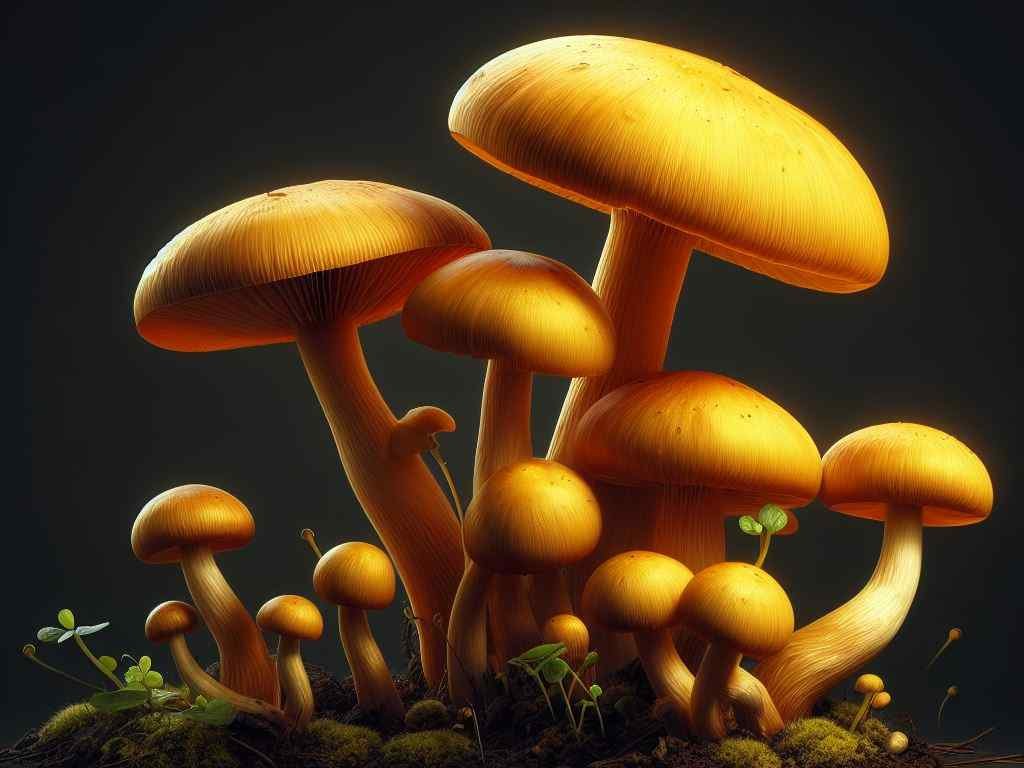
99. Saffron Milk Cap Mushrooms
These are edible mushrooms that are yellow and contain a modest amount of protein.
100. Yellow Swamp Brittlegill (Russula claroflava)
An edible mushroom that grows in coniferous forests.
101. Yellow Fieldcap (Bolbitius titubans)
This mushroom is small and yellow, often found on dung or grassy areas. It’s not typically consumed due to its small size and insubstantial flesh.
102. Fly Agaric (Amanita muscaria)
While this mushroom is more commonly associated with its bright red variety, there are yellow forms of it. It’s toxic and should not be consumed.
103. Golden Scalycap (Pholiota aurivella
This mushroom is often found growing on trees and is not recommended for consumption.
104. Yellow Stainer (Agaricus xanthodermus)
This mushroom looks similar to the edible field mushrooms but turns chrome yellow when bruised. It’s toxic and can cause gastrointestinal distress if consumed.
Other Foods That are Yellow
Besides the foods we’ve already mentioned, there are many other yellow foods that you can enjoy. Here are some of them:
105. Butter
This delicious dairy product is a staple in many kitchens. Butter is yellow because it contains beta-carotene a natural pigment. Which is also present in many yellow fruits and vegetables.
106. Honey
Depending on the type of flowers the bees visit, honey can range in color from light yellow to dark amber.
107. Mustard
Mustard gets its bright color from the addition of turmeric.
108. Cheese
Many types of cheese are naturally yellow, including cheddar, which gets its color from annatto, a natural dye made from the seeds of the achiote tree.
109. Eggfruit
Also known as canistel, this tropical fruit has a sweet, custard-like flesh that is bright yellow in color.
110 Chrysanthemum Flower Tea
This tea is made from dried chrysanthemum flowers and has a bright yellow color.
111. Cornflakes
This popular breakfast cereal comes from corn and has a bright yellow color.
112. Yellow Rice
This rice dish gets its yellow color by adding turmeric or saffron to the cooking water, giving it a delicious flavor.
113. Mac and Cheese
This classic comfort food is made with macaroni noodles and a creamy cheese sauce that is often bright yellow in color.
114. Semolina
This flour is made from durum wheat and is often used to make pasta and couscous. It has a bright yellow color.
115. Mashed Potatoes
Some mashed potato recipes call for the addition of egg yolks, giving them a bright yellow color.
116. Chanterelles
These mushrooms have a bright yellow color and a delicate, nutty flavor. They are often used in soups, sauces, and risottos.
117. Cheese Puffs
These crunchy snacks are made from cheese and cornmeal and have a bright yellow color.
118. Cornbread
This classic Southern bread is made with cornmeal and has a bright yellow color and a slightly sweet flavor.
119. Polenta
This Italian dish is made from boiled cornmeal and has a bright yellow color. It can be served creamy or firm, depending on the recipe.
121. Baked Potatoes
Some baked potato recipes call for the addition of turmeric, giving them a bright yellow color.
122. Tortilla Chips
These crispy snacks are made from corn and have a bright yellow color.
123. Limoncello
This Italian liqueur is made from lemon zest, alcohol, water, and sugar. It has a bright yellow color and a sweet, lemony flavor.
124. Zucchini Flowers
These delicate flowers are often stuffed with cheese and fried. They have a bright yellow color and a mild, slightly sweet flavor
Edible Seeds that are Yellow
125. Flax Seeds
While they are more commonly found in brown, there are golden or yellow varieties of flax seeds.
126. Sesame Seeds
There are yellowish sesame seed varieties, though they are less common than white or black sesame seeds.
126. Millet
This is a small-seeded grain that can be yellow, among other colors.
127. Sunflower Seeds
While the outer shell is typically black or striped, the actual seed inside can have a yellowish hue, especially when hulled.
128. Pumpkin Seeds (Pepitas):
Some varieties, when hulled, can appear golden or yellowish, though they are often more greenish.
129. Safflower Seeds
Often used as bird feed or pressed for safflower oil.
What gives yellow food its color?
Yellow foods derive their vibrant hues primarily from the natural pigments present within them.
Carotenoids are a broad class of pigments responsible for many of the yellow, orange, or red colors we see in foods.
For instance, Beta-carotene, present in foods like carrots, sweet potatoes, and some leafy greens, often imparts an orange color but can also contribute to yellow hues in certain foods.
Another set of carotenoids, Lutein and Zeaxanthin, are mainly present in leafy greens, corn, and egg yolks, giving them their characteristic yellow color.
Flavonoids are another group of compounds that can color foods. A notable example is Quercetin, which is present in onions, apples, and many other plants, often lending a yellow tint.
Anthoxanthins are a type of flavonoid pigment that can vary in color from white to yellow, depending on the pH level (acidity or alkalinity) of the food. Common foods containing anthoxanthins include potatoes and cauliflower.
Another yellow compound is Riboflavin (Vitamin B2). This yellow-green vitamin can contribute to the color of some foods, especially those that are fortified.
Curcumin is the vibrant yellow pigment found in turmeric. It’s not only responsible for turmeric’s color but is also often used as a natural food coloring in various dishes.
Lastly, Annatto, derived from the seeds of the achiote tree, is a natural coloring agent that can give foods a yellow or orange shade.
It’s essential to be aware that while many yellow foods obtain their color from these natural sources, some processed foods might use artificial food dyes. Always consult the ingredient list if you’re curious about the origins of a food’s color.
Check this post to discover blue food ideas for your party.
Benefits of foods that are yellow
Yellow foods, characterized by their vibrant hues, are packed with health-enhancing nutrients. Many, like turmeric and citrus fruits, are rich in antioxidants that neutralize harmful free radicals, reducing the risk of chronic diseases and promoting skin health.
Essential compounds like lutein and zeaxanthin, found in corn and yellow bell peppers, support eye health, potentially warding off age-related conditions. Additionally, foods such as bananas offer dietary fiber for improved digestion and potassium for heart health.
Moreover, The anti-inflammatory properties in items like pineapples and the bone-boosting vitamin K in yellow peppers further underscore the benefits of including yellow foods in a balanced diet.
Last Thoughts on Food That are Yellow in Color
In conclusion, yellow foods, rich in antioxidants from natural pigments like carotenoids and flavonoids, offer both health benefits and visual appeal. From nutrient-packed fruits like bananas to versatile vegetables like corn, they enhance meals with their flavors and textures. Whether it’s blending mango into smoothies or grilling corn for a salad, adding yellow foods to your diet is a flavorful way to boost health. Next time you shop, remember to grab some yellow produce!

